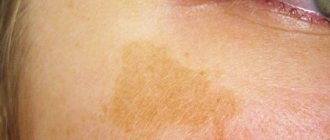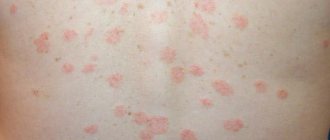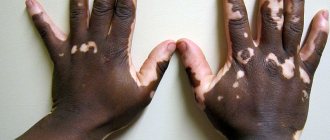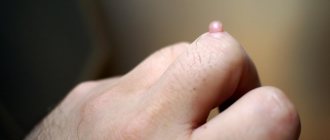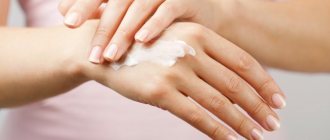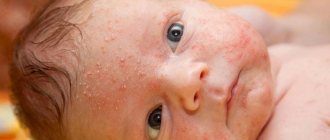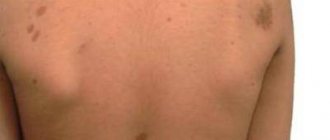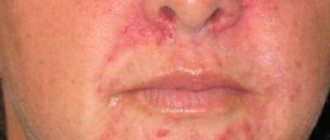Changes in the skin, characterized by the appearance of brown spots, are called lentigo , more simply referred to as liver spots. Outwardly, they are similar to freckles, but their size is much larger. This phenomenon gets its name from the color characteristic. Most often they are located on the skin of the face and hands, and appear after the age of 40.
The opinion that this phenomenon is associated only with liver pathologies is incorrect. This manifestation can occur with increased skin pigmentation. The phenomenon itself is not considered harmful, but such a cosmetic effect can affect the quality of life.
Causes of diseases
The liver has tremendous potential. It is very resistant to harmful factors. In addition, it has the ability to recover. However, liver disease can develop as a result of certain factors. Symptoms on the skin are the first signal that the organ gives to know about the development of pathology. Before considering them, let’s look at what can become a source of disease:
- Viral agents. They provoke inflammatory processes in the liver, in acute or chronic form. As a result, a person develops hepatitis.
- Toxic influence. A constant supply of harmful compounds (heavy metals, vapors, chemicals) can lead to organ damage. Such a clinical picture is also observed after immediate exposure to high doses of toxic substances.
- Drug influence. Some medications have quite an aggressive effect on the liver. These are hormones, antibiotics and chemotherapy drugs.
- Alcohol. Abuse of alcoholic beverages has a detrimental effect on liver cells. As a result, cirrhosis may develop.
- Parasites and infections. The most destructive to the organ are: roundworms, alveococcus, echinococcus, and the causative agent of leptospirosis. They can become a source of pathological changes and provoke cystic transformation of the organ.
- Poor nutrition. Abuse of fried, fatty, smoked foods and spices leads to disruption of the outflow of bile. As a result, stones may form in the ducts.
- Heredity. Developmental defects and genetic diseases often underlie the occurrence of pathologies.
- Acute diseases in the abdominal cavity. Suppurative processes can spread to the portal vein. As a result, thrombosis occurs.
- Abdominal injuries. The consequences can appear even several years later, after suffering blows or injuries. Sometimes cysts or fluid accumulations are found in the parenchyma of the organ.
- Ionizing radiation, chemical carcinogens. This exposure can become a source of cancerous degeneration of areas of the liver.
How to determine that spots are related to liver pathologies
The human body is a complex system of interactions in which pathological processes can manifest themselves in unexpected ways in places that seem outwardly unrelated. Changes in the skin often occur for reasons that have nothing to do with liver pathologies:
- lentigo, in addition to hepatic etiology, can be senile, childhood, hereditary and solar in origin;
- chloasma and melasma develop against the background of stable hormonal imbalances, taking inappropriate medications, using low-quality cosmetics, and untested cosmetology methods;
- a rash in the form of small dots (the so-called itchy dotted rash) can be the result of poor nutrition, abuse of bad habits, allergic components that are not detected and eliminated in time;
- red acne and papules are a frequent consequence of smoking and taking medications, the presence of parasitic infestation (often helminthiasis with an advanced course);
- a papular rash that does not affect the face, localized on the limbs and back, can be the result of any permanent intoxication.
The most likely cause of skin rashes seems to be a disease, the treatment of which is within the competence of an allergist and dermatologist. Disorders of the digestive system are constantly attributed to poisoning, the consequences of excessive alcohol intake, and banal pathologies of the gastrointestinal tract. The average person without medical knowledge rarely correlates nausea, vomiting and bowel dysfunction with liver disease, especially if the organ itself does not give any indicated signals for the time being.
In order to ensure that liver function is impaired, it is necessary to compare all the signs of the ongoing disease. In diseases of the exocrine gland, none of the symptoms inherent in the disease work separately. There must be a characteristic symptom complex that manifests itself in the later stages. At earlier, asymptomatic stages, a problem-free cure would still be possible, but if it comes to skin rashes of any kind that can be regarded as liver spots, treatment should begin immediately.
Signs of pathologies
As a rule, liver disease is accompanied by skin symptoms. It is, first of all, a yellowish tint. In addition, the patient experiences heartburn and feels nauseated. There is a sharp, extremely unpleasant odor of sweat. Therefore, typical cases do not cause difficulties in diagnosis.
In most cases, a doctor can already visually suspect liver disease. Skin symptoms and the patient’s discomfort give the doctor an idea of the nature of the pathology.
The main signs of liver diseases are:
- pain, discomfort in the organ area;
- liver enlargement;
- general malaise, weakness;
- headache;
- impairment of thinking and mental abilities;
- swelling;
- increased sweating;
- jaundice;
- skin itching;
- rash;
- increased tendency to bleeding, fragility of blood vessels;
- symptoms of hypovitaminosis;
- changed color, character of feces, unstable stool;
- the presence of a venous pattern on the abdomen;
- weight loss;
- increased abdominal size;
- bitter taste in the mouth;
- temperature reaction;
- cracks in the tongue, white or brown coating on it.
Treatment of liver spots
The most important thing is that you should not self-medicate. If you have liver spots, you should definitely contact a specialist who will examine you and prescribe the correct treatment.
A large number of cosmetic companies offer various medications and cosmetics for removing stains. However, the problem is within you, and after some time they will return again. It is better to focus efforts on combating the source of the problem than to mask it.
The liver is an amazing organ. She is capable of self-regeneration even in the most advanced cases, so if you help her, recovery will go faster. You should take medications as directed by your doctor, undergo procedures and follow a diet. Treatment of any of the diseases is carried out in various ways:
- In case of cirrhosis, treatment is aimed at stopping the processes of decay of organ structures. It includes the use of medications and diet.
- To get rid of diseases of the gallbladder and its ducts, you need to methodically take choleretic drugs. Also, one of the methods of non-surgical treatment is remote ultrasound lithotripsy. However, if the stones are too large, then only surgery will help. Now medicine offers the most modern methods of removing stones: crushing them with a laser, endoscopic cholecystectomy or open abdominal surgery.
- If a person has parasites, they are treated with antiparasitic drugs. If they do not help, surgical excision is used, then restorative measures.
- In the case of hepatitis, antiviral medications and a strict diet are used.
One way or another, the best option is to turn to a professional, if only to avoid making things worse. After all, health is one thing, and you need to preserve it with all your might. Take care of yourself!
The liver is a vital organ in the human body. If you feel constant discomfort, and the ultrasound results reveal dark or light areas, this may be signs of tumors in the liver. Formation in the liver - how dangerous is it? We will talk about common types of tumors and methods of their treatment.
Nature of pain
Most organ pathologies are immediately reflected on the human body and face. This allows you to promptly suspect liver disease. Skin symptoms are often accompanied by painful discomfort. The nature of the sensations can be quite different. Therefore, you should pay attention to the following discomfort:
- The occurrence of minor pain in the right hypochondrium. It can be aching and bursting. Or give a feeling of heaviness. This pathology signals a sluggish process of inflammatory, toxic origin. Discomfort often occurs as a result of organ enlargement or stretching of the liver capsule. As a rule, the patient cannot clearly identify the pain point.
- Intense, widespread discomfort in the right hypochondrium. This kind of pain is rare. It signals a pronounced purulent, inflammatory or traumatic process. Sometimes it can be characterized by stone damage to the bile ducts.
- Local, severe point pain in the liver area. Discomfort is not typical for liver damage. It is associated with pathology in the gallbladder or extrahepatic ducts.
Sometimes the patient does not experience pain, but meanwhile develops liver disease. Skin symptoms are the only signs that indicate pathology. As a rule, the absence of pain is observed with indolent diseases that go undetected for a long time.
Spots on the skin due to various diseases
The liver is a gland that functions as a kind of filter in the human body. After entering the blood, toxic compounds that can harm human health begin to oxidize in the cells of this organ, after which they are excreted in the feces.
In addition, fat-soluble vitamins are broken down in the liver . If the liver does not work properly, then the metabolism will suffer first, since there is a violation of the breakdown of lipid compounds and cholesterol accumulation occurs. This gland also plays a special role in the functioning of the immune system and hematopoiesis. Various pathologies that cause disturbances in the functioning of the liver and biliary tract can have a negative impact on the entire human body as a whole.
The very first sign of such disorders is the formation of rashes and spots on the skin. Such pathologies are divided into several categories:
Vascular, for example, pylephlebitis and thrombosis.- Inflammatory processes that are of viral etiology, for example, tuberculosis, hepatitis and syphilis.
- Damage to the bile ducts, which may include cholestasis and cholangitis.
- Oncological pathologies, including cyst, sarcoma, angiosarcoma, hemangioma.
- Parasitic pathologies and infections, for example, ascariasis, echinococcosis and others.
- Hereditary pathologies.
- Autoimmune abnormalities.
- Degeneration of the structure, for example, cirrhosis.
Any of the above diseases can cause a change in skin tone. Since itching, rashes and redness of the skin are often associated with allergic reactions and dermatitis, it is also necessary to pay attention to other existing symptoms that confirm dysfunction of the liver gland, as well as the bile ducts.
Other symptoms:
- Discomfort after eating foods, especially fatty foods, indigestion.
- Green color of stool.
- Yellow nail plates.
- Increased sweating, which can smell very unpleasant.
- Congestive acne, as well as increased formation of boils on the body.
- Fever.
- Dry mouth.
- Brittle nails and hair loss.
- Painful sensations in the right hypochondrium.
- Pain on palpation.
- High fatigue.
- Bitterness in the mouth.
- Sharp weight loss.
- Retardation in action.
Skin manifestations
The nature of the body cover can provide information about the functioning of various organs. This also applies to pathologies such as liver disease. Symptoms on the skin (the photo demonstrates these manifestations) can be quite varied.
The patient should pay attention to the following changes in the epidermis:
- Pale or, on the contrary, dark skin. Quite pronounced sweating. There is swelling of the subcutaneous tissue in the area of the limbs and face.
- Flaky, dry epidermis. There are many scratches and cracks on the surface.
- Increased tendency to allergic rash, psoriasis, atopic dermatitis, eczema.
- Jaundiced skin. This type allows you to determine pathology. With moderate yellowness with an orange tint, liver problems are diagnosed. With mechanical damage to the organ, a brown tint is observed. Lemon yellow color indicates hemolytic pathology.
- Presence of stretch marks. Striae are localized in the abdominal area. They often appear as bluish stripes. Stretch marks occur as a result of hormonal imbalance when the liver can no longer detoxify excess steroid hormones.
Skin changes not associated with liver disease
Cause of occurrence
Lentigo is the localization of melatonin in the skin. Liver spots are light to dark brown in color and resemble an oval plaque, flat or slightly convex. In some cases, several spots may merge. Such a flaw appears on open areas of the skin exposed to sunlight. Lentigo in rare cases appears from birth, but more often it occurs with age. People call them age spots or sun spots.
Age spots on hands
Among the causes of liver spots, it should be noted:
- consequences of traumatic processes;
- infectious diseases of the skin;
- pregnancy and changes in the body's hormonal balance;
- exposure to sunlight, sunburn;
- age-related changes.
Areas of the skin that have previously been exposed to various injuries or infectious processes in some cases are susceptible to the appearance of liver spots after a certain period of time. The same applies to areas of the skin that have suffered from the effects of excessive sun exposure.
When an imbalance of hormones occurs in the body, in particular estrogen and progesterone, it leads to an increase in the activity of melatonin, as a result of which age spots can form on the skin. This phenomenon is also observed during pregnancy. The pigment is most often localized around the nipples, eyes, and in the navel area. In some cases, changes in pigmentation in pregnant women are irreversible. But all this is physiological in nature, and does not cause concern in connection with lentigo.
Read also:
Skin spots and rashes in diseases of the pancreas
The cause of hormonal imbalances can be the use of certain medications; increased pigmentation is especially common due to the use of hormonal contraceptives.
Over the years, the skin wears out. Large localization of melatonin in certain areas provokes the appearance of age spots.
Lentigo on the back
Other types of similar skin defect
Despite the fact that the external signs of liver spots are quite easily identified, they are sometimes confused with other manifestations. Nevi (birthmarks) and moles may have a similar appearance to lentigines.
All changes in pigmentation on the skin do not pose a danger if they have the correct shape, do not grow and are not prone to bleeding and other changes. If the spot changes shape, color or its usual properties over time, in this case it is necessary to conduct a thorough medical examination to exclude the possibility of melanoma formation.
The specialist who deals with this problem is a dermatologist-oncologist. Self-medication and cosmetics in the presence of dangerous changes will only cause harm and will be a waste of precious time.
Types of liver spots
This defect has its own classification.
There are three types of pigmentation changes:
- youthful;
- senile;
- solar.
Juvenile lentigo (simple) can appear from birth and has hereditary causes.
Age spots
Senile is characteristic of older people. It manifests itself as changes in pigmentation of different sizes and colors (from light to dark brown) and is most often localized on the face and hands.
Solar lentigo most often appears on the facial surface of the palms, shoulders and face.
The risk group includes fans of solariums, older people and those to whom nature has given fair skin.
The spots tend to increase in size and spread to other areas, and may become darker over time.
Treatment of cosmetic skin defects
One way to lighten dark skin spots is to use ointments containing hydroquinone. If a defect causes trouble, such products will help make it less noticeable. A noticeable improvement is observed after 1.5 months of use. This method has one drawback: the effect of the ointment is short-lived, and the treatment should be repeated periodically.
Read also:
Skin rashes due to liver disease
Lentigo as a result of injuries can disappear on its own. If the cause of the defect is the use of hormonal drugs, then a simple way to solve the problem is to stop taking the drugs. Don't expect a quick effect. The spots disappear at intervals of up to a year.
Cryotherapy
In cosmetology clinics, unwanted pigmentation is eliminated using laser procedures. They are painless and effective, but quite expensive. In addition to the above methods, you can choose cryotherapy (by exposing the skin to a stream of liquid nitrogen) or photorejuvenation. It is worth noting that cryotherapy does not give a 100% result and its side effect may be the appearance of scars.
Even if the problem does not pose a health hazard, you should not solve it yourself, without consulting specialists.
In folk medicine, masks and rubs with lemon juice, cucumber, elderberry and other ingredients are recommended. Masks made from white soap in combination with ammonia and hydrogen peroxide are also offered.
Since this defect is physiological, instead of different ways to eliminate it, you can choose preventive actions. Namely: protect yourself from exposure to the sun at its peak. Using sunscreen, wearing brimmed hats, sunglasses, and a sensible approach to tanning can protect against unpleasant surprises.
Characteristic rash
The development of pathology can be signaled not only by changes in the skin. Many patients experience various rashes.
Sometimes the following symptoms occur:
- Pustular elements. There is a tendency to form furunculosis and folliculitis. The source of such rashes is an immune imbalance. It occurs as a result of decreased liver function. The organ is not able to synthesize immunoglobulin in sufficient quantities.
- Allergic manifestations. This pathology in most cases characterizes liver disease. Skin symptoms: spots and papules, occur as a result of a violation of the detoxification function of the organ. That is why a person is faced with the occurrence of allergic reactions to familiar conditions.
- Hemorrhagic rash. Minor hemorrhages are observed on the surface of the skin. They are called petechial eruptions. They characterize a decrease in the synthetic function of the organ. Initially, the protein contained in the blood suffers. As a result, patients have an increased tendency, even with the slightest damage, to form hematomas.
Why does the skin change in liver disease?
With liver failure, not only the color of the skin changes, but also the shade of the sclera of the eyes. If the dark yellow tint in people with European skin type can be mistaken for a tan, then the diseased mucous membrane reveals itself immediately. The relationship between the epidermis and the liver becomes especially noticeable when the organ, overloaded with harmful compounds, begins to fail. Dark yellow and brown spots on the body due to liver disease are the result of the release of toxins into the blood. These toxic substances slow down metabolic processes in the skin and provoke its modifications.
Features of pathology in children
Unfortunately, liver disease can often occur in children. Symptoms in children are quite difficult to recognize. Especially when it comes to infants. After all, even the most characteristic symptom, icteric coloration, can be interpreted as a natural physiological process.
You can suspect the presence of pathology in a baby based on the following signs:
- jaundice persists for more than 2 weeks;
- weakly colored stool indicates stagnation of bile, sometimes it becomes completely discolored;
- an enlarged tummy in a baby - this sign may indicate the occurrence of liver failure.
Even if you have the slightest suspicion that your child has a problem, you should definitely contact your pediatrician.
General recommendations
Following simple rules can maintain the health and beauty of the dermis. For people with very fair skin color, it is recommended to avoid visiting a solarium or limit time spent in the open sun. Other recommendations to avoid recurrence of the problem:
- in the summer, try not to go out in the sun without applying sunscreen or clothing; you can use a wide-brimmed hat to protect your face and shoulders;
- choose cosmetics with SPF of at least 30;
- regularly use facial care products that contain antioxidants;
- Avoid alcohol-based lotions and makeup removers.
You need to pay attention to nutrition and the condition of the gastrointestinal tract. Gastritis, ulcers, liver failure, cholecystitis and other pathologies affect the condition of the epidermis. It is necessary to monitor the condition of the body, adhere to proper nutrition and regularly arrange fasting days. It is recommended to eat more foods that are rich in vitamin C, K or B.
Liver spots on the face appear for many reasons; sometimes they can only be identified by a specialist after examination. You need to contact him even if the rash does not itch and is not accompanied by other symptoms. Nowadays, removing skin defects does not take much time and effort if you approach this issue carefully.
You can ask your question to our author:
Treatment of pathologies
The necessary treatment can only be determined after a diagnosis has been made. It depends on what skin symptoms indicate liver disease. Treatment includes many drugs that eliminate the clinical manifestations of the pathology and actively combat its causes.
For almost any liver disease, therapy includes one of the hepatoprotectors:
- "Gepabene."
- "Bonjigar."
- "LIV-52".
- "Result Pro".
- "Hepadif."
Treatment
Before starting any treatment, you should consult a doctor. After the examination has been completed and the cause has been established, the doctor will tell you how to remove spots on the body and how to get rid of pigmentation on the face. You can get rid of liver spots using various cosmetic and medicinal products that are applied externally.
For coarser and more extensive spots, the doctor will prescribe medications to cleanse the liver, hepatoprotectors, with the help of which it will be possible to prevent further spread of pigmentation and reduce the severity of existing lentigines.
It must be remembered that even if the problem can be eliminated with the help of medications, folk remedies or laser removal, after a while it may reappear if the provoking factor continues to be in the body.
Therefore, it is very important to first get rid of the cause of this phenomenon, and only then begin treatment. In addition, if the underlying cause is eliminated, the pigmentation may disappear on its own. The most common methods for removing lentigo include:
- the use of special pharmaceutical creams, the task of which is to lighten spots,
- the use of traditional methods - cucumber, oat masks,
- use of liquid nitrogen,
- photo stain removal,
- rejuvenation procedures – mesotherapy,
- laser removal,
- chemical peeling (salicylic, retinoic, Jessner).
Folk remedies
Unconventional methods can also help lighten your skin. They can be used along with pharmacy whitening creams.
You can lighten pigmentation using the following means:
- Sorrel. A mask of crushed pulp is applied to the face for 20 minutes. Do this procedure at intervals of 2 days.
- Chickweed. Prepare a decoction based on the plant, wipe your face with it morning and evening.
- Avocado. You can use crushed fresh fruit pulp as a mask. Or you can buy an avocado extract at the pharmacy and lubricate your face with cosmetic oil every day.
- Papaya. With the help of fruit enzymes, pigmentation is effectively lightened. Grind or crush the pulp and apply as a mask. Repeat several times a week.
- Lemon. Squeeze lemon juice and mix with egg white in equal parts. Apply to skin using a cotton pad.
- Onion juice and apple cider vinegar. Mix the components and apply to the epidermis.
The use of folk remedies helps fight hyperpigmentation. But you need to get ready for long-term treatment.
Laser stain removal
Using modern methods, liver spots can be removed quickly and painlessly. More than one procedure will be required. Laser polishing is carried out in the autumn-winter period, when solar activity is low.
This procedure is carried out only in specialized institutions. After three procedures, the first effect will be visible.
At the same time, the root cause of the problem should be eliminated.
Diet food. Exclusion from the diet
However, not only drug therapy is important for patients whose symptoms indicate liver disease. Diet is a prerequisite for effective treatment.
It is recommended to exclude from your diet:
- milk, full-fat sour cream, kefir;
- offal;
- fat meat;
- raw garlic, onion;
- fatty fish;
- radish, rutabaga;
- mushrooms;
- tomatoes, sorrel, legumes;
- sour fruits, berries;
- alcohol, carbonated drinks, coffee, strong tea;
- chocolate.
Encyclopedia of Ultrasound and MRI
The liver is the largest human gland; its functions are diverse and necessary. The two most important ones include detoxification (the liver cleanses the blood of toxins and breakdown products) and digestion (the liver produces bile enzymes and fatty acids).
In addition, the liver participates in the metabolism of proteins and fats, maintains blood glucose levels, synthesizes a number of vitamins and biologically active substances, regulates water-salt metabolism, and fights antigens that penetrate the bloodstream due to active phagocytosis by astrocytes of the liver capillaries. It is not surprising that any disruption to the functioning of such an important organ leads to a deterioration in a person’s well-being, and often to various diseases.
Ultrasound examination provides information about the liver in both children and adults. The child’s liver has sonographic features, which will be discussed below.
Diet. Healthy foods
If you have liver disease, eat the following foods:
- slightly stale (rye, wheat) bread, biscuits, biscuits;
- lean meat (rabbit, turkey, chicken, beef);
- fish - pike, pike perch, cod and other low-fat species;
- dairy products - low-fat kefir, cottage cheese, yogurt, fermented baked milk, yogurt;
- oil (sunflower, olive, butter);
- eggs (1 piece per day);
- vegetable dishes from pumpkin, potatoes, carrots, beets, zucchini, cauliflower;
- cereals – rice, buckwheat, oatmeal, pearl barley;
- pasta - any variety;
- fruits, berries (strawberries, strawberries, raspberries, blueberries);
- dried fruits and uzvar;
- fruit jam, honey (a little), marmalade.
Products must be steamed. It is allowed to eat food stewed, baked or boiled. Smoked and fried foods are prohibited.
With proper nutrition, many patients feel their liver disease receding. Symptoms and treatment (diet and drug therapy) should be monitored by a doctor throughout the entire period of combating the pathology.
Cosmetology against rashes
Cryotherapy will have a good effect in the fight against hyperpigmentation. When the dermis is exposed to liquid nitrogen or a laser beam, a person experiences almost no discomfort. Laser therapy and photoremoval are the most effective methods that can remove deep-lying formations of dark colors. After the procedure, liver disease spots lighten, and you can also notice a rejuvenation effect. It is not recommended to get rid of the rash in large areas, as scarring may occur.
Photoremoval involves exposing the skin to pulses of light that destroy the accumulation of melanin. The procedure is practically painless and, unlike laser, does not leave even small scars - this is important if the procedure is done on the face. Very sensitive skin may feel a little red or sting after the session, but this will go away quickly. On average, it will take 2-4 procedures to remove multiple lesions on the face.
Peeling with chemicals “burns out” old skin, and healthy skin appears in its place. Shallow formations are easily removed using similar methods. During the session, a composition based on fruit or trichloroacetic acid is applied to the dermis of the face, chest or neck. Immediately after the procedure, the treated areas turn red, but the reaction quickly passes. Use this method to bleach deep liver stains on the face and hands, otherwise a chemical burn may occur.
Removing dark spots using mesotherapy involves administering a special preparation under the skin, which removes excess pigment. The procedure does not cause much pain, since beauty salons are increasingly using devices that make micropunctures in the dermis.
If the causes of the rash are gastrointestinal diseases, then it is necessary to start therapy as quickly as possible. Many diseases quickly regress and cause not only defects on the skin, but also serious damage to internal organs. Antihistamines or metronidazole can help relieve severe itching. Any disease should be treated by a specialist; for this reason, you should refrain from taking any medications on your own. If the liver is damaged by cirrhosis, it is necessary to take medications to stop the process of cell breakdown, as well as a strict diet.
| Products and dishes | It is acceptable to include in the diet | Should be excluded from the menu |
| Fats | Vegetable and butter | Lard, margarine, shortening |
| Soups | With vegetable or chicken broth, as well as dairy and fruit dishes | Meat and fish broth, soups with mushrooms, sauerkraut, beets |
| Meat | Rabbit, chicken, turkey, beef (boiled or steamed) | Fatty varieties (pork, ham), as well as sausages and canned food |
| Fish | Dietary species (pike perch, carp, cod) | Catfish, sturgeon and other fatty varieties |
| Fermented milk products | Natural cottage cheese, yogurt, kefir, milk, yogurt (sour cream can only be added to salads) | Cream, cheeses, full-fat milk |
| Eggs | Only for preparing various dishes, no more than 1-2 pieces per day | Raw and hard-boiled eggs, scrambled eggs |
| Vegetables and fruits | Almost anything can be done; vegetables that are difficult to digest must be boiled. | Unripe products |
| Sweets | Honey, marshmallow, marmalade | Chocolate, pastries, ice cream, cakes |
Pathologies of the gallbladder are treated with special means for the outflow of bile, diet and physiotherapy, but sometimes surgical intervention is required to save life. If liver spots appear on your face, you should get tested for parasites and get rid of them if they are found.
Folk remedies
There are many witchcraft recipes to overcome liver disease. Be sure to discuss symptoms and treatment with folk remedies with your doctor.
The most popular methods are:
- Oats. You will need 2 tbsp. spoons of unrefined grain. Fill the component with a liter of water. Boil the ingredients over low heat for 15-20 minutes. Then add 2 tbsp to the contents. spoons of milk (preferably goat milk). This product should be boiled for another 5 minutes. Then strain the resulting broth and add honey (2 tablespoons) into it. Should be consumed half an hour before meals three times a day, 1/3 cup. Treatment with this remedy should last two weeks.
- Herbal decoctions. Traditional medicine advises choosing plants with yellow flowers. For liver diseases, herbal decoctions of St. John's wort, immortelle, chamomile, tansy, and milk thistle are useful. You will need 1 tbsp. spoon of herb per 1 cup of boiling water. The composition should be boiled for 1-2 minutes over low heat. After straining, the decoction is ready. Drink it half an hour before meals three times a day, 1/3 cup. As a rule, the course of treatment lasts about 10 days.
Follow all your doctor's recommendations and stay healthy!
Common causes of violations
It is quite easy for a person to become infected with one of the liver diseases. Hepatitis, for example, can be transmitted through unwashed fruits and vegetables, or while shaking hands. Hepatitis B and hepatitis C are sexually transmitted and can also be transmitted from mother to child during childbirth.
Parasites that affect the liver can enter the human body during contact with animals, as well as after eating meat products that have not been heat-treated. Parasites live freely in open water and soil. Failure to comply with the dosage of medications can negatively affect liver function.
Smoking and alcohol lead to slow but irreversible intoxication of the entire human body. Excessive consumption of fatty pork, deep-fried foods, and poor nutrition can lead to stagnation of bile and the development of the disease. Quite rarely, a predisposition to liver gland dysfunction is transmitted genetically.
What types of spider veins are there on the body?
Depending on the vessels undergoing pathological expansion, three types of asterisks, or telangiectasias, are distinguished:
- Capillary - inconspicuous, formed from small blood vessels.
- Venous ones are larger in size.
- Arterial - even larger, visible to the naked eye.
Asterisks in cirrhosis are red and blue. There are four types based on form:
- Spot. A dark dot surrounded by blue streaks of capillaries. Located on the legs. A significant amount is capable of forming spots.
- Tree-like. They look like a twig with branches, the color is blue, and are found in the thigh and lower leg area.
- Arachnids. They have a center, an arteriole, from which “spider legs” - capillaries - diverge. Of red color.
- Linear. They look like parallel lines, of any color; their favorite places to localize are the nose and cheeks.
This is interesting: Liver cirrhosis: prognosis at different stages of the disease and complications
Treatment of spider veins
To remove stars as a cosmetic defect, different techniques are used:
- Therapeutic. Wearing compression clothing, massages, using masks that strengthen facial blood vessels.
- Medicinal. Taking medications aimed at strengthening vascular walls - ascorutin.
- Surgical. Removing stars. Electrocoagulation is used - cauterization of localization sites. Radio wave surgery - removal using high frequency radio waves. Sclerotherapy is the introduction of a sclerosant into the vessels, a gluing agent that stops blood flow in the vessel. Ozone therapy is an injection of an oxygen-ozone mixture. Laser photocoagulation - burning with a laser beam.
- Traditional methods.
| Compound | Mode of application |
| Green tomatoes. | Cut off the peel and apply to the affected area for ten minutes to expose the juice. Remove, rinse, apply emollient cream. |
| Apple vinegar. | Spot lubricate the star area up to four times daily. |
| Cabbage, carrot, plum juices. | Take orally, alternate. |
| Yarrow, egg yolk, cream, honey, a teaspoon of lemon juice, a tablespoon of starch and sour cream. | Mix gradually, adding ingredients one by one, and pour a glass of boiling water. Apply for ten days, fifteen minutes per defect. |
| Calendula, chamomile. | Mix, pour boiling water, leave for a day. Apply with compresses. |
| Chamomile, oak bark. | Brew with boiling water separately. Mix the decoctions and use them as baths. |
Cosmetic removal of stars for liver cirrhosis is a temporary solution to the problem. A progressive disease will again provoke the appearance of these symptoms. As your general condition improves, the stars will go away on their own.
The primary task is to fight the main disease, cirrhosis:
- Diet. Table number 5. Refusal of fatty, spicy, smoked, fried, salty foods. Alcohol ban. Moderate salt restriction. Meals are served six times a day, every three hours in small portions.
- Limiting physical activity.
- Drug therapy - hepatoprotectors, diuretics, beta blockers.
- Symptomatic therapy for the development of complications.
- Donor organ transplantation.
This is interesting: What is the head of a jellyfish in liver cirrhosis?
